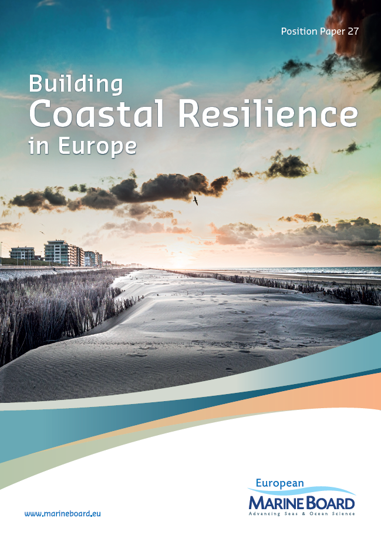Output
 The output of this working group is Position Paper No. 27 'Building Coastal Resilience in Europe', which can be downloaded here, and Policy Brief. No. 12 'Requirements for Coastal Resilience in Europe', which can be downloaded here.
The output of this working group is Position Paper No. 27 'Building Coastal Resilience in Europe', which can be downloaded here, and Policy Brief. No. 12 'Requirements for Coastal Resilience in Europe', which can be downloaded here.
It was launched at the EurOCEAN conference on 10 October 2024 and during an online launch on 19 October 2023. You can find more information and the link to re-watch the launch webinar here.
Background
Coastal zones are particularly vulnerable to threats from increasing human pressures e.g. urbanisation, tourism, agriculture, fisheries & aquaculture, dredging, waste disposal, coastal engineering, and increases in greenhouse gas emissions with subsequent effects on sea level rise, water temperature, and ocean acidification. All these factors are contributing to habitat decline, which comes at a time when coastal zones are already being used at, or near, their maximum carrying capacity to meet the needs of an ever-increasing human population. Eurostat data revealed that in 2011, more than 40.8% of the EU population lived in coastal regions (regions with a sea border or where more than half of the population lives within 50 kilometres of the sea) which covered 40% of the EU territory. High coastal human population density and excessive exploitation of natural resources puts enormous pressure on our coastal ecosystems, leading to biodiversity loss, habitat destruction, pollution, as well as conflicts between potential uses, and spatial planning problems.
The EMB Autumn Plenary 2018 identified a potential new EMB activity relating to coastal resilience. Despite conservation efforts, ecosystems continue to degrade due to human development, resource exploitation and climate change. The United Nations have already recognised the importance of restoration in the coming decade (2021-2030) with the establishment of the UN Decade of Ocean Science for Sustainable Development (2020-2030) and the UN Decade on Ecosystem Restoration. These will provide significant opportunity to scale-up ecosystem conservation and restoration and for scientists, policy makers, industry and society to work together to find the best solutions to sustain the ecosystem services provided by the wider ocean and coastal habitats. In March 2020, The European Commission presented its new Biodiversity Strategy, which includes commitments to address the main causes of biodiversity loss in the EU, underpinned by measurable objectives that address the main causes of biodiversity loss. Additionally, through the European Green Deal the “The Commission will consider drafting a nature restoration plan and will look at how to provide funding to help Member States to reach this aim”. Therefore, it is timely to provide adequate scientific input to this “nature restoration plan”, with a focus on the coastal areas.
This working group provides input to the UN Decade of Ocean Science for Sustainable Development (2021-2030) societal outcome that aims for a healthy and resilient ocean.
Objectives
- Provide an overview of the current state of the art in methods and tools for coastal resilience, knowledge gaps, and problem definition for future challenges;
- Help close the gap between conservation and restoration research and policy in the European marine environment and contiguous regions (and discuss the contradictions between economic and environmental policy drivers);
- Evaluate existing frameworks for transboundary cooperative planning; and identify and propose future developments for conservation and restoration measures;
- Inform EU policy on the need for legislation that will ensure/promote science-based decision making in coastal conservation, restoration, habitat and biodiversity management;
- Build capacity and literacy in coastal ecosystem conservation, restoration, and resilience among stakeholders including scientists, policymakers, the private sector and the wider public.
Terms of Reference
The Terms of Reference produced for the operation and objectives of this Working Group can be consulted here (June 2020).
Members
Chair: Sebastian Villasante, Assisant Professor, University of Santiago de Compostela, Spain.
Co-Chair: Kristin Richter, NORCE Norwegian Research Centre & Bjerknes Centre for Climate Research, Norway.
Working Group members:
Andres Payo, British Geological Survey, UK
Donata Melaku Canu, Istituto Nazionale di Oceanografia e di Geofisica Sperimentale - OGS, Italy
Eugene Farrell, National University Ireland Galway, Ireland
Frederic Bouchette, Université de Montpellier, France
Isabel Sousa Pinto, University of Porto, Portugal
Jennifer Bailey, Norwegian University of Science and Technology (NTNU), Norway
Karen Timmermann, DTU Aqua, Denmark
Liam Lachs, University of Newcastle, UK and EMB Young Ambassador Alumnus
Margaret Chen, Vrije Universiteit Brussel (VUB), Belgium
Remi Mongruel, Ifremer, France
Thorsten Blenckner, Stockholm Resilience Center, Sweden
Tjeerd Bouma, Royal Netherlands Institute for Sea Research (NIOZ), the Netherlands
EMB Communication Panel support: Aaike van Oord - Royal Netherlands Institute for Sea Research (NIOZ), the Netherlands
Contact at European Marine Board Secretariat: Britt Alexander Email